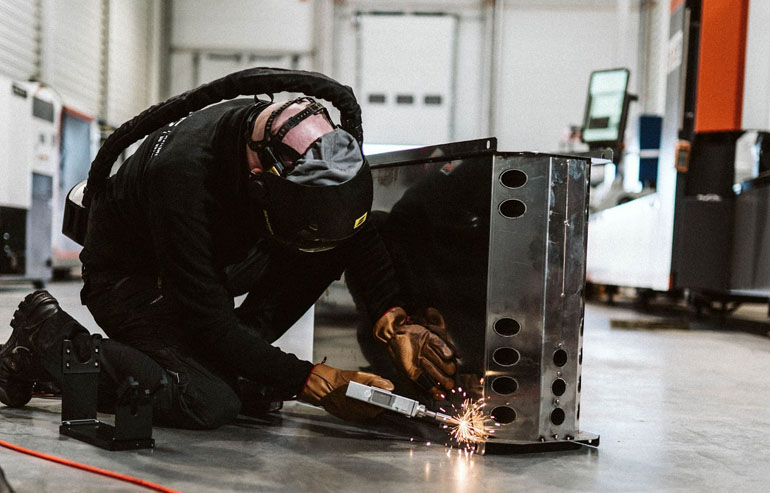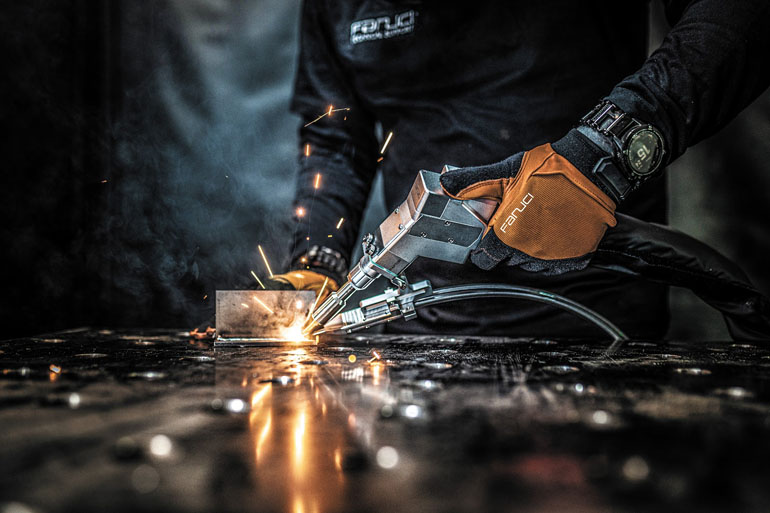In industry, precision, speed and reliability matter, and one of the technologies that meets these requirements is laser welding. This advanced technology finds application in many industries - from automotive, through electronics, to the production of medical devices. By using a high-power density laser beam, this method allows for the creation of durable connections while minimizing deformations and changes in the mechanical properties of the material. In this article, we will look at the laser welding process, specifically its advantages and limitations.

What is laser welding?
Laser welding is an advanced technology for joining materials, in which a high-power density laser beam heats and melts the metal surface, creating a durable connection. It is one of the commonly used methods of joining elements in mass production, where high precision, repeatability, and minimal material deformation are key.
The laser welding process can be carried out using pulse or continuous lasers. Pulse lasers are particularly useful for welding electronics, medical devices, and thin materials because they allow for control of the amount of energy delivered.
Various welding parameters are used in the laser welding process, which have a key impact on the quality of the connection. The most important include:
-
laser power - determines the amount of energy delivered to the material,
-
welding speed - affects the depth of penetration and the shape of the weld,
-
shielding gas flow rate - prevents oxidation and affects arc stability,
-
pulse repetition frequency - important in pulse welding, where control over the amount of heat delivered to the material surface is important.
Advantages of laser welding
Laser welding has many advantages that make it widely used in industry. The most important benefits include:
High precision and quality of welds
Advanced laser welding technology allows for the creation of clean welds with minimal width. This makes the method ideal for applications requiring high accuracy, such as the production of medical devices or electronics welding.
Small heat affected zone (HAZ - heat affected zone)
Unlike traditional welding methods, laser welding involves less heating of the surrounding material, which reduces the risk of deformation and preserves the mechanical properties of the welded element.
Ability to weld difficult materials
Laser welding enables joining of stainless steel, structural steel, aluminum, and other difficult-to-weld alloys. Due to the high power density of the beam, the process can be used for chemically active metals that are difficult to join using other methods.
Process speed
Through the use of laser light, laser welding offers significant benefits in terms of high speed of making precise welds, which increases efficiency and reduces production costs.
Possibility of automation
Laser systems can be easily integrated with industrial robots, allowing for a fully automated process. This is particularly important in mass production, e.g., when joining body elements in the automotive industry.
No need to use filler material
In many cases, laser welding does not require additional filler material, which reduces costs and improves the aesthetics of the weld.
Challenges of laser welding
Despite numerous advantages, laser welding also comes with certain challenges. The disadvantages of laser welding include high purchase costs and limitations related to material thickness.
High investment costs
Purchasing and maintaining a laser welder is much more expensive than traditional welding methods. This cost includes not only the device, but also shielding gases, optical systems, and cooling. However, what's worth knowing is that the prices of laser welders depend on many factors, such as laser power, technologies used, automation capabilities, or additional functions. Professional systems, such as Fanuci welders, offer a wide range of power and configurations, which allows for matching the device to specific production requirements. Currently, various series of devices are available on the market, including budget ones, so even smaller companies can use this technology.
Investment in laser welding may initially be costly, but in the long run, it translates into savings resulting from greater efficiency, lower operating costs, and precise welds without the need for additional processing.
Material thickness limitations
Although laser welding is characterized by high power, it has material thickness limitations. This method works best with thin and medium-thickness elements. In some cases, it is necessary to use filler material or combine it with other welding methods, e.g., hybrid laser welding.
Laser welding: advantages and limitations
The table below presents the most important advantages and limitations of laser welding, which are worth considering before choosing this method.
|
Advantages of laser welding |
Limitations of laser welding |
|
High precision and quality of welds |
High investment costs |
|
Process speed |
Limitations in material thickness |
|
Ability to weld difficult metals |
Need for shielding gases |
|
No deformations and post-process treatment |
Sensitivity to working conditions |
|
Possibility of automation |
Increased health and safety requirements |
Summary: laser welding in practice
Laser welding shows that this method offers significant benefits in terms of precision, speed, and quality of execution. It is widely used in the automotive industry, electronics, and the production of precision parts, such as structural elements or medical devices.
However, laser welding requires careful selection of parameters to avoid deformation or defective welds. Before implementing this technology, it is worth analyzing the welding limitations and assessing the profitability of the investment in the context of production specifics.
Will laser welding work in your company? The choice of this method should be carefully considered, especially if high quality, repeatable welds, and durable material joints are of key importance.
Laser welding with Fanuci devices
For companies looking for efficient and modern welding solutions, Fanuci laser welders can be a perfect match. Fanuci provides advanced laser systems that not only increase production efficiency but also minimize operational costs. Thanks to the state-of-the-art fiber technology, Fanuci devices guarantee clean welds, high precision, and reliability. They will therefore be an excellent choice for companies from the automotive, industrial, or metallurgical industries.

Why choose Fanuci laser welders?
Wide selection of models adapted to different needs
Fanuci offers both stationary and portable laser welders, which allows for flexible adaptation of the device to the specifics of production. Models such as FANUCI 5.0 PRO GenX are suitable for intensive production processes, while FANUCI 5.0 PRO Portable is a great solution for companies needing mobility and easy transport of equipment.
Fiber technology ensuring savings and quality
Thanks to advanced fiber optic technology, Fanuci welders are characterized by high energy efficiency and minimal consumption of consumable materials, which translates into lower operating costs.
Read: Why is a fiber laser a good investment?
Modern laser technologies
Contemporary laser technologies enable even greater precision and speed of welding processes, while minimizing the effect of heat on the surrounding material. Their development means that laser welding systems are becoming more versatile and accessible to various industries.
Ease of use and intuitive control
Modern interface and the ability to precisely adjust welding parameters make the operation of Fanuci devices simple and intuitive, even for less experienced operators.
Are Fanuci laser welders a good choice for your company?
Choosing the right welding equipment is an investment for years, so it's worth analyzing the available options carefully. Although cheap laser welders tempt with an attractive price, they may involve compromises in terms of quality, durability, and work efficiency.
If your company needs efficient, economical, and precise solutions for laser welding, it is worth considering Fanuci devices. Innovative technology, high efficiency, and the ability to adapt to various industrial applications make them an excellent choice for both large production plants and smaller workshops.
